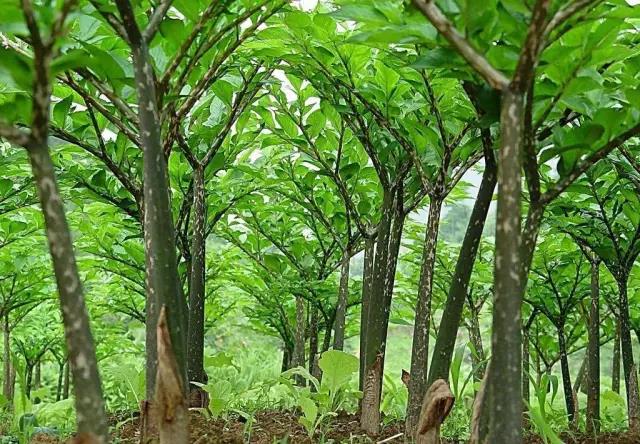
High-yield Cultivation Techniques of "Qingjiang Flower Konjac"
1. Preparation before broadcasting
1. Choose a place. In the region of 900 to 1400 meters above sea level, there is a light sandy loam with deep soil layer, loose soil, rich organic matter content, water retention and fertilizer, and no waterlogging. In front of the house, beside the ditch and forest. Avoid land where the previous crops are Solanaceae and Cruciferous crops. The pH value of the soil is around 6.5-7.0.
2. After confirming the taro field, deep plow before winter, and sprinkle 50kg of quicklime per mu for soil disinfection before plowing the land.
3. Choose healthy seed taro of various specifications such as 10-200g (choose one of the specifications) to eliminate disease, rotten and damaged taro.
4. Fertilizer preparation: prepare 1500-2000 kg per mu of fermented and decomposed farmyard manure. 50 kg potassium sulfate compound fertilizer per mu.
5. 10 days before sowing, choose fine weather and spray once with glyphosate to weed.
Second, sowing
1. Planting time
The planting time in the Ershan to Alpine region is about mid-to-late April. Generally, the planting should be started after the temperature of the 10 cm thick soil layer stabilizes above 15 ℃, and the planting should be delayed correspondingly when the altitude rises.
2. Disinfect before broadcasting
The selected seed taro is sterilized before sowing with 72% agricultural streptomycin at a concentration of 200-500ppm, and after soaking, it is taken out and dried before sowing.
3. Planting method
Row spacing: Sow seeds at 6 times the diameter of the seed taro. Plant spacing: Sow the seeds at 4 times the diameter of the planting taro.
Sowing: 1) Open the ditch and spread the decomposed farmyard manure or sprinkle potassium sulfate compound fertilizer on the bottom; 2) Cover with a layer of fine soil to cover the fertilizer; 3) Plant the taro, place the bud on the top of the taro slightly inclined to avoid Water in the bud nest causes the bud nest to rot. If the taro is a rhizome, the top buds should be placed in one direction; 4) Cover the soil to form a row.
3. Field management
1. Fertilization
Apply foot fertilizer and try to avoid top dressing.
2. Weeding
Pre-emergence weeding, artificial weeding, glyphosate or acetochlor spraying can be used for weeding. For weeding after seedlings, choose herbicides that do not harm konjac plants. When spraying, avoid spraying on konjac plants as much as possible. Do not weeding manually.
3. Pest control
A. The disease of konjac is mainly to prevent:
1) Replace disease-resistant varieties; 2) Select healthy seed taro; 3) Disinfect the taro plant before sowing; 4) Disinfect the field after changing crops; 5) Use decomposed farm manure; 6) Prevent water accumulation in the field; 7) Apply enough Base fertilizer, avoid top dressing, apply more potassium fertilizer and less nitrogen fertilizer; 8) Cover cultivation, intercropping for shade; 9) Chemical weeding; 10) Cover planting.
B. Konjac diseases and prevention methods:
1) Soft rot: Mainly manifested as rot with foul smell. The leaflets of the plant appear water-soaked dark green spots at the beginning of the onset, and the half of the leaves of the plant are yellow, commonly known as "half wind". Later the whole compound leaf rotted and fell down. Prevention and treatment methods: Once the disease occurs, there is no medicine to cure the diseased plant. The measures taken are to completely pull out the diseased plants, take the package out of the garden and burn it, spread lime on and around the sick nest, step on the soil tightly, and irrigate with agricultural streptomycin (concentration of 1g streptomycin in 500ml of water) , So as to prevent the rainwater from spreading germs.
2) White sclerotia disease: It occurs at the base of the petiole, initially as white filaments, gradually turning into rapeseed-large granular sclerotia, and finally turning yellow or dark yellow, and the plants fall down. Prevention measures: deep plowing the farmland before winter, sprinkling quicklime or spraying Bordeaux mixture in the early stage of the disease. Pull out the diseased plant, take it out of the garden and burn it.
3) Insect prevention: spray with yellow cardboard or carbaryl to kill.
4. Other matters needing attention
1) Hands have been in contact with diseased plants, and hands must be washed before touching other plants.
2) Konjac is called a lazy crop, try to avoid entering the garden for management.
Four, harvest
1. The konjac plants can be dug after they fall normally for about 20 days. Commodity taro is generally harvested after the frost and good weather for planting taro after the beginning of winter (if it is in a low-altitude area or a place where it does not freeze, the taro can be planted in the winter, and the land for the winter is ready to be used for the ground. The small holes left after the plants fall down are blocked, and the anti-icing water flows into the konjac bud nest, causing rot. The ridges should be covered with hay and other materials for heat preservation.).
2. When harvesting, pay special attention not to dig the tubers. After digging up, dry the epidermis on the spot, then return to the stall and dry it in a ventilated and rainy place, pick out the commodity taro for sale, and continue to spread the taro until it loses water 15 %The rear basket is stored indoors.